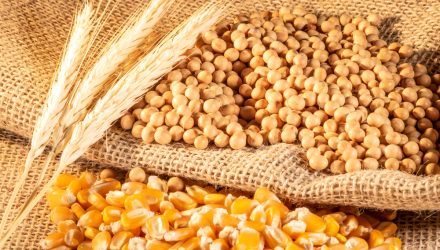After a surge in agricultural prices over 2021, grains-related exchange traded funds could be in for a more volatile year ahead, with high fertilizer prices, severe weather, and threats of slowing Chinese demand all potentially contributing to more oscillations in soft commodities.
In 2021, the Teucrium Corn Fund (CORN) increased 41.5%, the Teucrium Wheat Fund (NYSEArca: WEAT) rose 25.9%, the Teucrium Soybean Fund (NYSEArca: SOYB) gained 17.0%, and the Invesco DB Agriculture ETF (DBA) added 23.5%.
Row crops in 2021 climbed to multiyear highs amid a surge in global demand and rising inflation, and farmers are largely expected to increase planting to capitalize on the momentum, the Wall Street Journal reports.
According to IHS Markit data, farmers are projected to plant roughly 230 million acres of soybeans, wheat, and corn in 2022, or 2 million acres more than the past year’s record-beating levels.
Analysts anticipate that grain prices will pull back in 2022 as global supplies meet the recent demand spike. In the meantime, prices have already somewhat eased since touching record highs in May, but remain at elevated levels not seen in eight years.
Year-to-date, corn futures on the Chicago Board of Trade are 25% higher, wheat futures are up 27%, and soybeans are up over 2%.
The strong planting is seen as a cap on how much further grain prices may grow.
“This crop year, we’re seeing a projected rebuild of inventory. That would suggest there’s a lid on prices,” Jake Hanley, a senior portfolio strategist with Teucrium Trading LLC, told the WSJ.
Furthermore, analysts and investors warn of additional factors that could weigh on the grains markets. For example, geopolitics could be the biggest wild card, with tensions between the U.S. and China, along with the buildup of Russian troops along its border with Ukraine, threatening to strain global relations.
Hanley warned that world wheat prices could surge if Russia, the world’s largest wheat exporter, invades Ukraine like it did in 2014 when it annexed the Crimean Peninsula.
China could also see demand drop with a slowing economy in 2022. China, the world’s largest buyer of grain exports, is expected to import more than 135 million metric tons of corn, wheat, and soybeans from around the world in the 2021-2022 marketing year, according to the USDA.
“I think the China commodity demand is directly linked to their GDP,” Michael Zuzolo, president of Global Commodity Analytics & Consulting, told the WSJ.
For more news, information, and strategy, visit the Commodities Channel.

